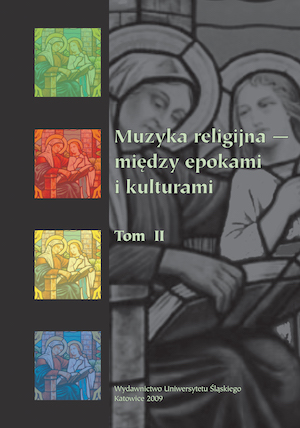Missa Requiem Damiana Stachowicza w aspekcie związków słowno-muzycznych
Missa Requiem by Damian Stachowicz in the context of verbal-musical relations
Author(s): Maciej JOCHYMCZYK
Subject(s): Music
Published by: Wydawnictwo Uniwersytetu Śląskiego
Summary/Abstract: Missa Requiem by father Damian Stachowicz (1658—1699) is one of the first interpretationsof the texts of a funeral service in seconda practica in the Polish music (probably theoldest one). The composition was created before 1693 whereas the information about itsperformance can be found in a description of funeral celebrations of WojciechSiewierkiewicz, the first prior of the Piarist college in Łowicz who died on 14th September1693.In his Requiem, Stachowicz interpreted both ordinarium missae — Kyrie, Sanctus, Agnus Deiparts as well as some of proprium — introitus, sequentia (apart from stanza no 5, 6, 12, 13 and16) and offertorium. He avoided graduale, tractus and communio. He also left out Christie andthe second Kyrie. The musical form remains tightly connected with the construction of a verbaltext. In its shape, Requiem is marked with similarities with the assumptions of dispositio —a rhetorical arrangement of the musical material, the model for which constituted the orator’sspeech.The work by Stachowicz contains many rhetorical-musical figures. They concern bothmelody, contrapunctal layer and the appropriate usage of pauses. The composer also makesuse of the illustrative effects deriving from the application of distant keys which, unequallytempered, sounded out of tune. Some of the parts of Requiem contain more rhetorical devicesthan the other. Obviously, the frequency of their usage depends on the quality of theverbal text. The fragments which influenced the composer in the strongest way constitutethe stanzas of Dies irae beginning with Quantus tremor, Quid sum miser, Rex tremendae,Recordare and Lacrimosa, as well as parts of Domine Jesu and Agnus Dei II.Stachowicz employs the majority of figures of the common music language, leaving no“meaningful” words without the proper musical illustration. It proves that the composer orientateshimself well in the current conventions especially as the Polish repertoire does notinclude the interpretations of a funeral service which he could follow as an example.
Book: Muzyka religijna – między epokami i kulturami. T. 2
- Page Range: 11-27
- Page Count: 17
- Publication Year: 2009
- Language: Polish
- Content File-PDF

